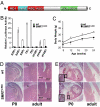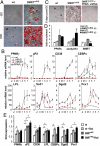SMRT repression of nuclear receptors controls the adipogenic set point and metabolic homeostasis
- PMID: 19066220
- PMCID: PMC2598729
- DOI: 10.1073/pnas.0811012105
SMRT repression of nuclear receptors controls the adipogenic set point and metabolic homeostasis
Abstract
The nuclear receptor corepressor, silencing mediator of retinoid and thyroid hormone receptors (SMRT), is recruited by a plethora of transcription factors to mediate lineage and signal-dependent transcriptional repression. We generated a knockin mutation in the receptor interaction domain (RID) of SMRT (SMRT(mRID)) that solely disrupts its interaction with nuclear hormone receptors (NHRs). SMRT(mRID) mice are viable and exhibit no gross developmental abnormalities, demonstrating that the reported lethality of SMRT knockouts is determined by non-NHR transcription factors. However, SMRT(mRID) mice exhibit widespread metabolic defects including reduced respiration, altered insulin sensitivity, and 70% increased adiposity. The latter phenotype is illustrated by the observation that SMRT(mRID)-derived MEFs display a dramatically increased adipogenic capacity and accelerated differentiation rate. Collectively, our results demonstrate that SMRT-RID-dependent repression is a key determinant of the adipogenic set point as well as an integrator of glucose metabolism and whole-body metabolic homeostasis.
Conflict of interest statement
The authors declare no conflict of interest.
Figures




References
-
- Perissi V, Rosenfeld MG. Controlling nuclear receptors: The circular logic of cofactor cycles. Nat Rev Mol Cell Biol. 2005;6(7):542–554. - PubMed
-
- Wang Z, et al. Critical roles of the p160 transcriptional coactivators p/CIP and SRC-1 in energy balance. Cell Metab. 2006;3(2):111–122. - PubMed
-
- Ge K, et al. Transcription coactivator TRAP220 is required for PPAR gamma 2-stimulated adipogenesis. Nature. 2002;417(6888):563–567. - PubMed
-
- Picard F, et al. SRC-1 and TIF2 control energy balance between white and brown adipose tissues. Cell. 2002;111(7):931–941. - PubMed
Publication types
MeSH terms
Substances
Associated data
- Actions
Grants and funding
LinkOut - more resources
Full Text Sources
Other Literature Sources
Molecular Biology Databases

